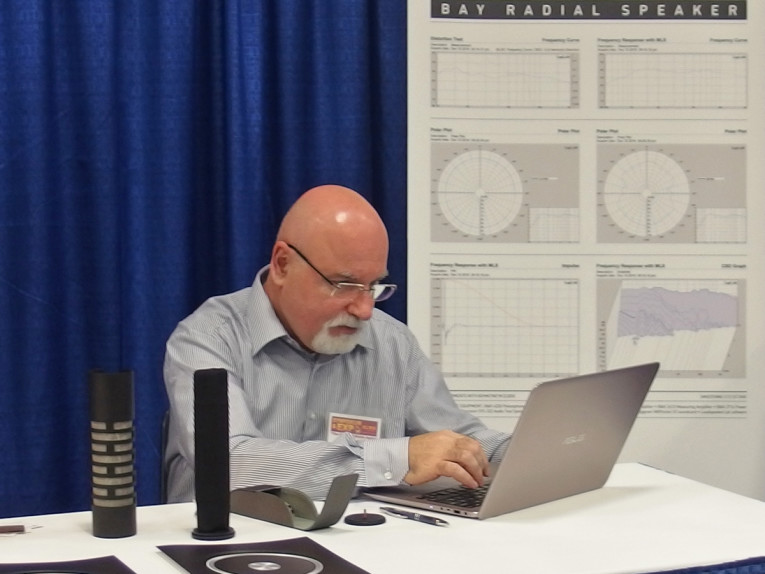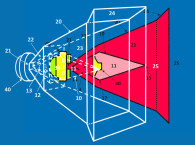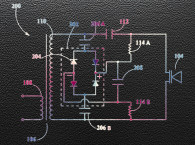
Loudspeaker
Patent Number: 9,088,849
www.freepatentsonline.com/9088849.pdf
Inventor: Zoltan Bay (Tiszaalpar, Hungary)
Assignee: Zoltan Bay (Tiszaalpar, Hungary)
Filed: September 26, 2012
Current CPC Class: H04R 7/16 (20130101)
Granted: July 21, 2015
Number of Claims: 20
Number of Drawings: 138k,
Abstract from Patent
The invention relates to a loudspeaker, which contains bearing structure, a magnetic arrangement (12) fixed to the bearing structure, determining air-gaps (13), and a diaphragm connected to the bearing structure, made of a sheet material (as shown in Figure 1 of this patent application). The diaphragm has the shape of a cylindrical jacket consisting of segments (10), the segments (10) are connected to each other along delimiting lines running in the direction of the generating lines, and they have a surface the curvature of which is larger than the curvature that belongs to the overall radius of the cylindrical jacket-like shape, there is a flap (11) at least along two delimiting lines, which flaps (11) extend into an air-gap (13) each radially, and the diaphragm is connected to the bearing structure with flexible supporting units joining the flaps (11) and allowing radial movement of the flaps (11) in the air-gap (13).

Independent Claims
1. A loudspeaker comprising: a bearing structure; a magnetic arrangement fixed to the bearing structure, the magnetic arrangement defining air-gaps, and a diaphragm connected to the bearing structure, made of a sheet material, characterized by: the diaphragm has a cylindrical jacket-like shape consisting of segments; the segments are connected to each other along delimiting lines running in the direction of the generating lines, and they have a surface curvature of which is larger than a curvature that belongs to an overall radius of the cylindrical jacket-like shape; there are flaps at least along two delimiting lines, which the flaps extend into the air-gaps each radially; and the diaphragm is connected to the bearing structure with flexible supporting units joining the flaps and allowing radial movement of the flaps in the air-gaps.
11. A loudspeaker comprising: a bearing structure; a magnetic arrangement fixed to the bearing structure, wherein the magnetic arrangement defines a plurality of air gaps; a cylindrical diaphragm connected to the bearing structure, wherein the diaphragm includes a plurality of curved segments connected to each other along a plurality of delimiting lines to form a plurality of flaps, wherein a surface of each segment in the plurality of segments includes a radius of curvature larger than a radius of curvature of the diaphragm; wherein each flap in the plurality of flaps extends into one of the air gaps in the plurality of air gaps; and a plurality of flexible supporting units joining the flaps to the bearing structure, wherein the plurality of flexible supporting units allow radial movement of each flap in the corresponding air gap.
16. A loudspeaker comprising: a bearing structure; a magnetic arrangement fixed to the bearing structure, wherein the magnetic arrangement defines an air gap; a cylindrical diaphragm connected to the bearing structure, the cylindrical diaphragm comprising: a diaphragm radius of curvature; a first curved segment having a first surface with a first radius of curvature; a second curved segment having a second surface with second radius of curvature; a flap, wherein the first curved segment is connected to the second curved segment along a delimiting line to form the flap, and wherein the flap extends into the air gap; wherein the first radius of curvature is larger than the diaphragm radius of curvature; and wherein the second radius of curvature is larger than the diaphragm radius of curvature; and a flexible supporting unit, wherein the flexible supporting unit joins the flap to the bearing structure, and wherein the flexible supporting unit allows radial movement of the flap in the air gap.
Reviewer Comments
The goal of the invention of this patent is to realize a horizontally, omni-directional loudspeaker transducer. The disclosed structure is essentially a multiple set of four to eight rolling, half-cylinder film diaphragms arranged in a circle to form a generally omni-directional radiator, with a voice coil attached to the junction of each pair of half-cylinders and the voice coil placed in a magnetic gap.
The invention and inventor are from Hungary, but those in the US will probably find this device’s basic structure familiar as the original 1986 Linaeum design by Paul W. Paddock, of Portland, OR. Mr. Paddock established the basic structure for this type of device in more than a dozen patents starting with US 4,584,439, “Audio Transducer With Controlled Flexibility Diaphragm.” To see a thorough exploration of this type of transducer, one can study the evolution of Paddock’s work over the next 15 years in his next patents on the subject; US Patent 4,903,308, US Patent 5,198,624, US Patent 5,230,021, US Patent 5,249,237, US Patent 5,446,797, US Patent 5,450,497, US Patent 5,570,429 US Patent 5,604,815, US Patent 5,652,801, US Patent 5,727,076, and US Patent 6,061,461.
The current patent discloses a general arrangement of multiple Paddock devices arranged to form an omni-directional device. Paddocks designs tended to be, monopole or bipolar radiators. The new patent discloses a few design details but a study of the Paddock patents may provide more information for those interested in how to actually realize optimization of the omni device under review.
Operating as a laterally expanding and contracting diaphragm surface, the horizontal dispersion for all forms of this type of device is quite wide.
But, one of the potentially problematic design issues is vertical dispersion. These structures tend to work best when either very short in height (less than 2”) or expressed as an extended line source, 1 to 2 m in height. The devices of intermediate heights, as shown in the patent, tend to have unfavorable vertical dispersion throughout the upper frequencies (above approximately 2 kHz).
This patent doesn’t show any frequency response or polar diagrams to illustrate the results from an actual device. It is a concern that when creating a horizontal circular horizontal array, the size and form of the individual half-cylinders can determine whether there are interference patterns causing horizontal lobes, particularly at higher frequencies where the distance from the outermost surface to the depth of the divot between the cylinders, or the center-to-center spacing between half-cylinders, is on the order of one half wavelength. The early Paddock designs had significant notches in the frequency response due to some of these problematic issues and diaphragm breakup modes.
The basic concept has always had great potential and with effectively optimized dimensions, and properly designed diaphragms to minimize surface resonances, the device should be able to provide good wideband performance and be one of the more effective ways to realize a horizontally omni-directional device. VC
This article was originally published in Voice Coil, September 2015.






